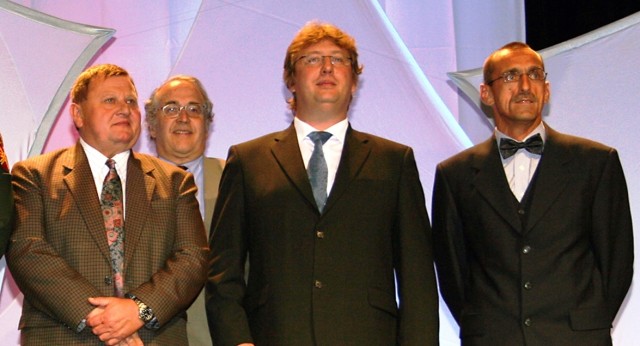
BAMBERG, Germany Aca,!" In an era of ever-increasing oil prices and questions about AmericaAca,!a,,cs commitment in preserving the environment, U.S. Army Garrison Bamberg has written an energy-saving success story thanks to a three-man crew from the Department of Public Works.
In fact, the trioAca,!a,,cs efforts garnered service-level attention as they received the Energy Efficiency and Energy Management Award from the 30th annual Secretary of the Army Energy and Water Management Awards. Overall, the hard work of Dieter Gerber, energy manager and chief of the Operation and Maintenance Divison; Juergen Engeter, privatization engineer; and Reinhold Schiller, mechanical engineer, delivered energy savings totaling 38,000 million British thermal units.
And while a combination of deployments and mild winters clearly helped to contribute about half of the savings Aca,!" roughly 19,000 MBTUs Aca,!" the threeAca,!a,,cs efforts still translates to a monetary savings of $450,000 for the year. And between the monetary savings and energy conservation, which in turn improves the environment, the trio made a huge impact at USAG Bamberg.
Their labors were lauded by many, including Diane Devens, director of Installation Management Command Europe, who said, Aca,!A"Great work by a great team.Aca,!A?
The energy savings were realized due to improvements in two major areas: better management of unoccupied buildings and optimization of the heating systems.
To achieve the savings, Gerber, Engeter and Schiller planned and then implemented a process to control temperatures, (heating) set points, nightly (temperature) set back and other facility oversight procedures throughout the garrison.
The plan called for a heat-management system to assume responsibility of a buildingAca,!a,,cs temperature operation rather than occupants of a unitAca,!a,,cs building. During past deployments, these buildings would be either minimally occupied or vacant. Consequently, heating management could go unchecked for some time, resulting in unnecessary heating of vacant buildings and vacant areas of minimally occupied buildings.
The key to managing unoccupied buildings is information flow. Getting such data to system operators is critical. With the newly developed process, the energy team was now in continuous contact with the master planning office to get the latest information about staging and deployment actions. As a result, unoccupied buildings were identified and appropriate actions taken. In some cases, it was even possible to consolidate semi-occupied buildings, which led to energy conservation by reducing building temperatures as vacant buildings were kept out of the freezing range only when needed to prevent water pipe damage.
The development of a heating system optimization plan was a little more complicated and involved a bundle of actions, including replacing circulation pumps with high-efficiency models and continuous adjustment of facility heating systems in accordance with building operations.
Also, the change to a new generation of heating-controllers was made. This new generation of controllers determines low-demand times and set-back temperatures automatically. USAG Bamberg developed a priority matrix for the replacement of controllers, allowing existing meters to be hooked up to the UEMC system to grab real-time consumption data for energy management.
Another area of focus: educating energy consumers. Energy conservation affects everybody at any installation, with many players in the mix Aca,!" users, building coordinators and occupants. Therefore, USAG Bamberg strives to educate the entire community on energy conservation. For example, a program to teach elementary school kids was initiated, as well as the training of building energy monitors. The goal: encourage people to take individual ownership when it comes to saving energy.
Why' Because everyone wins as those energy savings reduce air pollution by 2,850 tons of carbon dioxide. With the calculation that one tree can compensate the amount of 500 kg of carbon dioxide annually, the USAG BambergAca,!a,,cs energy savings are equal to the planting of 5,700 trees.

Social Sharing